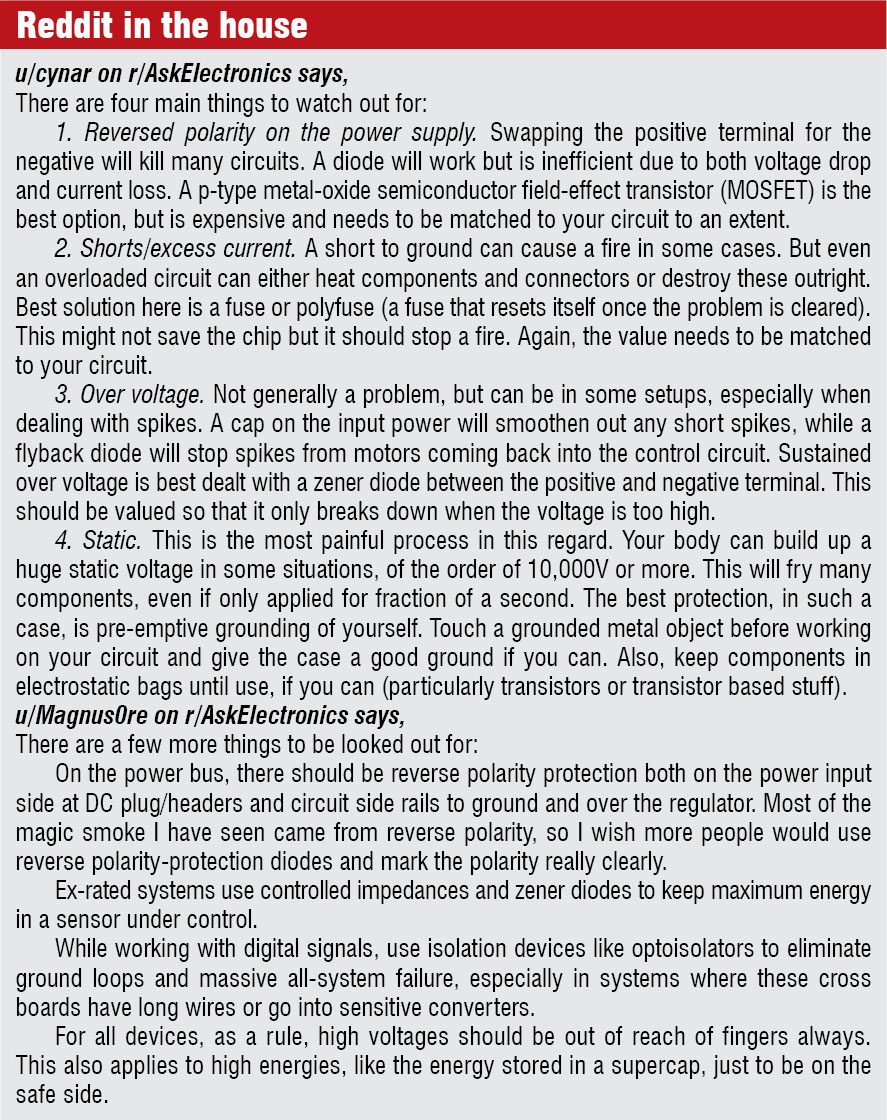Determining whether a circuit is adequately protected can require a high-level view of the electrical distribution system, from the fault current available at the source of supply down to the end device connected to the system. Circuit protection devices fulfil two primary purposes, namely, safety and reliability. Safety is assured by disconnecting the power in a circuit during over current, which eliminates electrocution and fire hazards.
In addition, the right protection may be necessary to comply with agency standards for some end products. Ranging from the classic fuse to schemes for protection against electrostatic discharge (ESD), these solutions are proof that simplicity still produces the best results. Thanks, freakonomics!
You take care of things valuable to you, monetary or otherwise. You may take care of your first love letter the same way a Trekkie would take care of his mint-condition Spock action figure. Closer home, the same level of diligent care is required to protect a small sub-circuit as in protecting a million-dollar sub-station. That is why circuit protection is immensely important (probably the biggest understatement in this article). Companies spend a lot in making sure their investments are safe. After all, what good is a device that does not work long-term or has the temperament of the South African cricket team in World Cup knockout games.

Aspects of circuit protection
If you have watched the movie Interstellar, or are aware of the infamous Murphy’s Law, then you know that, anything (bad) that can happen, will happen. Circuit faults can be generated internally because of problems in the system, or can come from external sources. The basic aim of circuit protection is to safeguard against loss of functionality, or degradation in performance, without affecting the core functionality of the system. It has three key elements: protection against mains voltage and its variations, protection against lightning and high voltage transients, and protection against ESD.
Internal problems can be due to over-current events such as a short circuit, or an overload current, and over-voltage events such as short-duration transient voltage spikes or longer duration over voltages. These faults can negatively impact sensitive electronic circuits, if not dealt with on time. External problems can include lightning interference, that induces surges inside the electronics; these travel from outside conductors on the grid to the inside of buildings and homes.
Most products need all three protection schemes, and the intensity of protection varies according to application. For example, if you are developing telecommunication products, your focus will be on mains and lightning. However, if it is a consumer product, the focus will be on ESD.

Srinivasa Moorthy, director, D4X Technologies Pvt Ltd, says, “Many times designers worry about the protection aspect after the design is complete and find out the problems only when the product fails in compliance tests. The key is to understand the compliance and protection needs. It is usually a matter of deriving protection parameters from the standards and implementing protection as part of the design, not as an afterthought. In my opinion, the most forgotten protection is the protection of communication connectors of the product against ESD.”
Abhinay Patil, field applications manager – key accounts, Analog Devices India, feels that design engineers need to perfect their workflow and not skip any aspects to ensure an optimum protection scheme. He explains, “There are certain international standards that define the tests an electronics system should pass to be certified as an EMI/EMC robust system, something essential to most products made for the consumer market. These tests include ESD, electrical fast transients (EFTs), surge, radio frequency interference (RFI) and others. The design engineer needs to have knowledge of these standards along with the operating conditions of the product, interference sources and mechanisms through which the interference can get coupled into the system, and the impact of the interference on the system.”
Patil adds, “Overlooking any one of these aspects can result in failure to design a truly robust system. Designers also sometimes fail to anticipate non-ideal operating conditions and human errors (like miswirings). So a system that works well in the lab under ideal conditions may fail when installed in the field. Yet another mistake designers may commit is to design the protection scheme only for transient events, while ignoring possible steady state conditions (like high AC/DC voltage on the signal or ground path).”
What is new in this field
Following the trend of going small in electronics, circuit protection has also taken strides in that aspect. New fuse technologies include constructions where voltage ratings and interrupt ratings, that were achievable in larger form factors, are now being implemented in smaller surface-mount devices.










